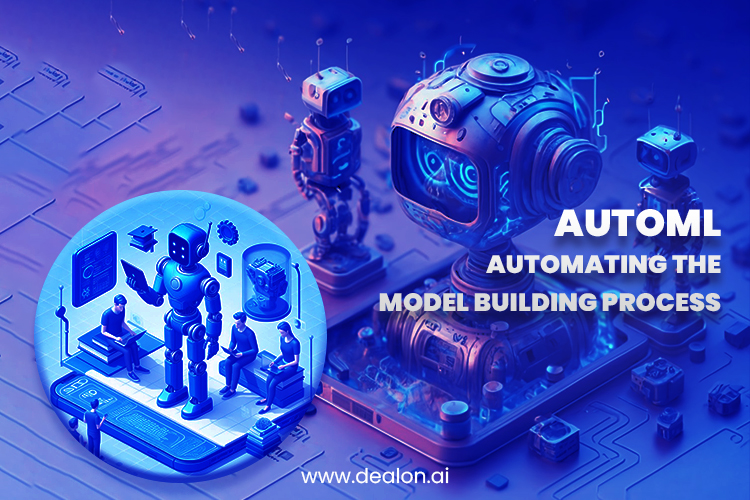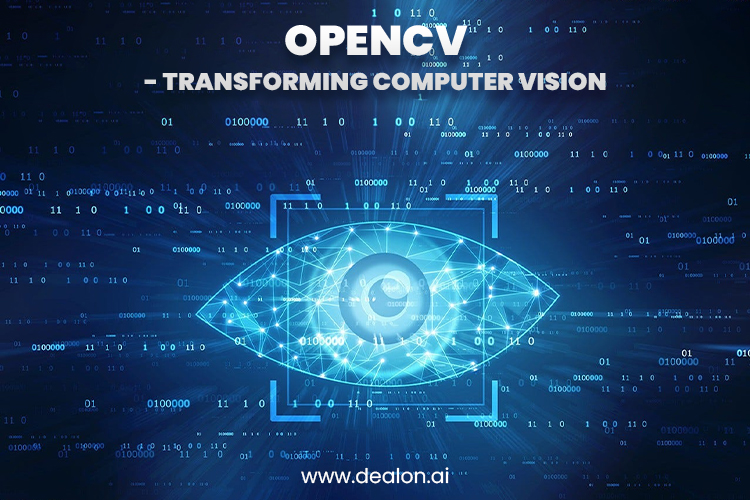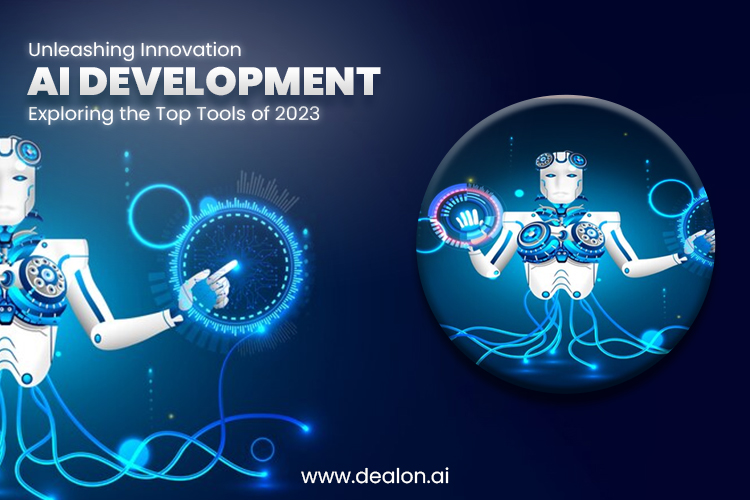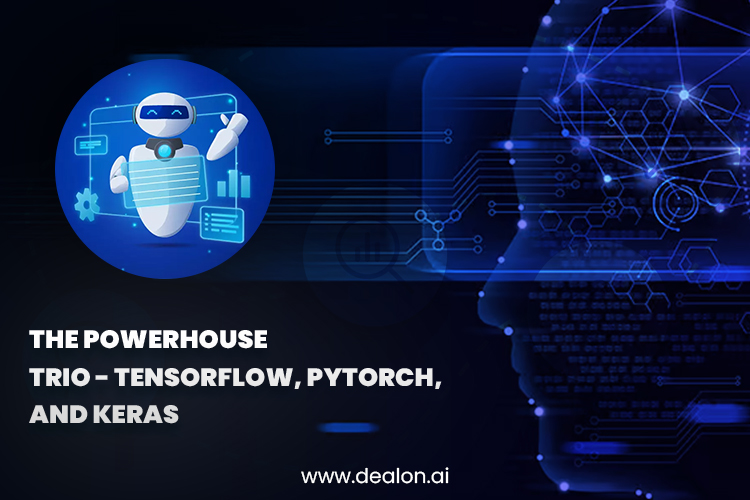In the swiftly advancing technology domain, 2023 marks a crucial juncture in the progression of artificial intelligence (AI). As businesses, researchers, and developers navigate the ever-expanding landscape of AI, staying abreast of the latest tools is paramount. This blog post is your gateway to the future of innovation, where we delve into the top AI development tools poised to redefine the boundaries of what’s possible. Artificial intelligence has moved beyond merely a trendy term, establishing itself as a fundamental force propelling significant change across various industries.
AI catalyzes groundbreaking solutions and unprecedented advancements, from healthcare to finance, entertainment to logistics. In this era of technological renaissance, understanding and harnessing the right tools can be the critical differentiator between stagnation and progression. The trio of TensorFlow, PyTorch, and Keras stands tall as the powerhouse enabling developers to sculpt the AI landscape. These frameworks have become the canvas upon which machine learning models are painted, offering a robust foundation for innovation.
Jupyter Notebooks, often hailed as a developer’s playground, provides an interactive and collaborative space for AI enthusiasts to experiment. Its versatility, supporting multiple programming languages, fosters an environment where ideas flourish and concepts come to life. In the ever-evolving world of AI, Jupyter Notebooks serve as the breeding ground for creativity and exploration.
As we traverse the landscape of AI tools in 2023, the spotlight also shines on AutoML, OpenCV, and Docker, each contributing uniquely to the multifaceted facets of AI development. AutoML automates the intricate model-building process, OpenCV transforms computer vision possibilities, and Docker containerizes AI applications for scalable deployment. Buckle up for an insightful journey into the heart of AI development, where innovation knows no bounds, and the tools we explore are the conduits to a future shaped by artificial intelligence. Let’s explore together as we unravel the mysteries and potentials of the top AI development tools defining 2023.
The Powerhouse Trio – TensorFlow, PyTorch, and Keras
Three pillars in the dynamic artificial intelligence (AI) development field stand prominently: TensorFlow, PyTorch, and Keras. Together, they form a powerhouse trio that has become synonymous with innovation and excellence in machine learning. At the forefront stands TensorFlow, a machine learning library crafted by Google, offered as open-source software for the broader community. Renowned for its versatility, TensorFlow provides a comprehensive framework for building and training various machine learning models. Its widespread adoption is evident across multiple industries, from healthcare to finance, as it allows for a robust foundation for tackling complex problems.
PyTorch, developed by Facebook’s AI Research lab (FAIR), is another heavyweight in this trio. Praised for its dynamic computational graph and intuitive design, PyTorch is favored by researchers and developers for its flexibility.
This flexibility makes it easier to experiment with and iterate upon models, a crucial aspect in the rapidly evolving landscape of AI research and development. Though often considered a high-level neural network API, Keras plays a pivotal role in this trio. Integrated seamlessly with TensorFlow and recently with PyTorch, Keras provides a user-friendly interface for constructing and training neural networks. Its simplicity and abstraction make it an ideal choice for those entering the world of AI development.
These three tools offer developers a comprehensive toolkit for building and training machine learning models. Whether the task involves image recognition, natural language processing, or any other AI application, TensorFlow, PyTorch, and Keras empower developers with the tools needed to create scalable and efficient solutions. The trio’s dominance in the AI landscape is a testament to their adaptability, performance, and the seamless integration they provide, making them an indispensable foundation for countless projects pushing the boundaries of artificial intelligence.
Jupyter Notebooks – A Developer’s Playground
In the continually evolving field of developing artificial intelligence (AI, Jupyter Notebooks emerge as a beacon of versatility, interactivity, and collaborative prowess. Jupyter notebooks have been positioned as an indispensable tool for AI enthusiasts and transcend the conventional boundaries of coding environments, providing a dynamic platform for seamless collaboration and interactive exploration.
At its core, Jupyter Notebooks are interactive web applications that facilitate live code execution, data visualization, and narrative text, all within a single, easily accessible interface. Their support for multiple programming languages, including Python, R, and Julia, sets them apart. This flexibility empowers developers to leverage the language that best suits their needs, fostering an environment where diverse skill sets can seamlessly converge.
One of the outstanding characteristics of Jupyter Notebooks is its role as a playground for AI developers. The interactive nature of these environments allows developers to experiment with code snippets, visualize data in real-time, and prototype machine learning models effortlessly.
This real-time interactivity enhances the development process, enabling developers to refine their code and algorithms iteratively, decreasing the time required to bring ideas to fruition.
Furthermore, Jupyter Notebooks serve as an effective tool for collaborative projects. Teams can share and collaborate on notebooks, fostering community and knowledge-sharing among developers. This communal aspect is especially crucial in AI, where diverse perspectives and expertise contribute to creating more robust and innovative solutions. In AI development, where data exploration, visualization, and model prototyping are pivotal stages, Jupyter Notebooks provide an all-encompassing solution.
AI enthusiasts can immerse themselves in a world where experimentation knows no bounds, ideas come to life in real time, and the collaborative spirit thrives. Dive into AI development with Jupyter Notebooks and witness the transformative power of a developer’s playground where creativity and innovation take center stage.
AutoML – Automating the Model Building Process

Welcome to the era of AutoML, a revolutionary chapter in artificial intelligence (AI) development where the once arduous tasks of model selection and hyperparameter tuning are streamlined to simplicity. AutoML, short for Automated Machine Learning, stands as a transformative force, making AI more accessible and accelerating innovation in the field. Developing machine learning models traditionally involved considerable manual effort, expertise, and time, particularly when selecting the exemplary model architecture and fine-tuning its hyperparameters.
AutoML changes this landscape by automating these intricate steps, allowing developers and data scientists to focus more on the high-level aspects of their projects rather than getting bogged down in the minutiae of model optimization. Prominent AutoML tools, such as Google Cloud AutoML and H2O.ai, have emerged as pioneers in this domain. These platforms leverage sophisticated algorithms to automate the end-to-end model development process, from data preprocessing to feature engineering, model selection, and hyperparameter tuning.
This outcome leads to the democratization of AI, allowing a more extensive audience with diverse expertise levels to leverage machine learning capabilities without navigating the complexities of intricate algorithms. By embracing AutoML, projects gain a substantial boost in efficiency and speed. The time-consuming and often perplexing aspects of model building are now handled by automated processes, allowing developers to focus on refining their problem statements, interpreting results, and deriving meaningful insights from their models.
This newfound efficiency not only accelerates the development cycle but also broadens the scope of AI adoption, paving the way for organizations and individuals to harness the benefits of AI without requiring extensive machine-learning expertise. AutoML marks a paradigm shift, ushering in an era where AI entry barriers are significantly lowered. As you venture on your AI journey, consider empowering your projects with the game-changing efficiency and speed that AutoML brings to the table – a transformative force that places the power of machine learning in the hands of a diverse and expansive audience.
OpenCV – Transforming Computer Vision

In the vast domain of AI tools, any thorough investigation would only be complete by recognizing the transformative potential of OpenCV. As a cornerstone in computer vision, OpenCV (Open Source Computer Vision Library) has earned its status as an indispensable toolkit for developers venturing into vision-based AI applications.
Explicitly designed for computer vision and machine learning applications, OpenCV provides a wealth of functions and algorithms that empower developers to process visual data with unparalleled efficiency. Its versatility spans various applications, including image and video analysis, facial recognition, object detection, and augmented reality, making it an invaluable asset for projects across diverse industries.
One of the standout features of OpenCV is its open-source nature, fostering a collaborative and innovative community of developers. This collaborative spirit has propelled the library to evolve continuously, incorporating state-of-the-art techniques and algorithms. As a result, OpenCV remains at the forefront of advancements in computer vision, ensuring that developers have access to cutting-edge tools for their projects.
OpenCV provides a robust foundation for developers seeking to integrate vision-based AI into their applications. The library supports various programming languages, including C++, Python, and Java, enhancing accessibility and applicability across different development environments. Whether you are working on a computer vision research project, developing an AI-powered application, or exploring the possibilities of augmented reality, OpenCV offers the tools needed to bring your vision to life.
Harnessing the power of OpenCV unlocks a new dimension of possibilities in AI development. From extracting meaningful insights from visual data to creating immersive and interactive experiences, OpenCV empowers developers to push the boundaries of what’s achievable in computer vision. As you venture on your AI journey, consider OpenCV as your ally, guiding you through the intricacies of visual data processing and opening doors to a world where AI seamlessly interacts with the visual realm.
Docker – Containerizing AI for Scalability
Scalability is paramount in the fast-paced artificial intelligence (AI) development landscape. Enter Docker – a game-changing technology that has revolutionized the deployment and management of AI applications. By containerizing AI applications, Docker provides a powerful solution for ensuring consistency, portability, and scalability across diverse computing environments.
At its core, Docker is a containerization platform that encapsulates applications and their dependencies into lightweight, portable containers. These containers are self-sufficient units that include everything needed to run the application, from the code and libraries to the runtime environment. This containerized approach eliminates the challenges associated with variations in system configurations, dependencies, and operating environments, offering a consistent and reproducible environment across development, testing, and production stages. In the context of AI development, where the complexity of dependencies and computational requirements can be substantial, Docker plays a pivotal role.
By encapsulating AI models and their dependencies into containers, developers can create a standardized environment that ensures seamless execution across different infrastructure setups. This consistency is crucial when deploying AI applications in diverse environments, from local development machines to cloud-based servers. Scalability is a defining characteristic of Docker’s impact on AI development.
The containerized nature of applications allows for efficient scaling, whether upscaling to handle increased computational loads or downscaling during reduced-demand periods. Docker’s capacity to dynamically oversee and distribute resources guarantees optimal functionality, positioning it as a preferred option for AI applications requiring adaptability and prompt responsiveness. Furthermore, Docker promotes portability, enabling developers to package their AI applications once and run them anywhere – on a developer’s laptop, in a testing environment, or on a production server. This portability simplifies the deployment process, enhances collaboration, and facilitates the seamless transition of AI solutions across various development and deployment stages.
Embracing tomorrow’s AI…
Our exploration of the top AI development tools for 2024 has unveiled a rich tapestry of technological advancements reshaping the landscape of artificial intelligence. The powerhouse trio of TensorFlow, PyTorch, and Keras stands as the bedrock of machine learning innovation, offering robust frameworks that empower developers across diverse applications. Jupyter Notebooks emerge as a dynamic playground for AI enthusiasts, providing an interactive and collaborative space for experimentation, data exploration, and model prototyping.
Its versatility in supporting multiple programming languages amplifies its impact, fostering an environment where creativity and exploration thrive. AutoML, represented by tools like Google Cloud AutoML and H2O.ai, heralds a new era in AI development by automating the once-intricate tasks of model selection and hyperparameter tuning. This mechanization speeds up the development process and broadens access to AI, extending its availability to a broader spectrum of users. OpenCV, recognized for its prowess in computer vision, revolutionizes the visual aspects of AI applications.
Its extensive library of functions and algorithms and its open-source nature place it at the forefront of innovation in image and video analysis, object detection, and augmented reality. Docker, our final contender, emerges as a game-changer in ensuring scalability and consistency in AI deployment. By containerizing AI applications, Docker provides a seamless and standardized environment across diverse computing setups, unlocking the potential for scalable and portable solutions.
As we traverse the continuously changing terrain of AI development, these tools form an all-encompassing set that enables developers to extend the frontiers of innovation. Covering model inception, deployment, collaboration, and scalability are the highlighted AI tools that present a comprehensive strategy for tackling the various aspects of challenges and opportunities within artificial intelligence. Embrace these technologies, discover their intersections, and embark on a path where ingenuity, teamwork, and effectiveness unite to shape the trajectory of AI development in 2024 and the years ahead.


